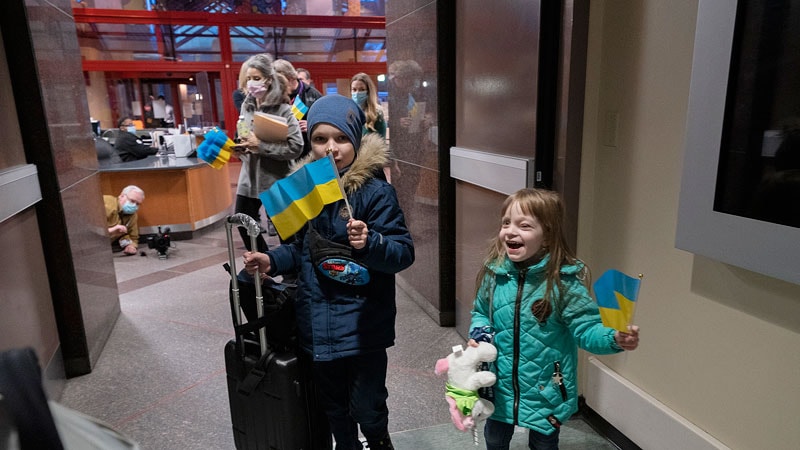As the war in Ukraine continues into its second month and refugees continue to flee the country, work is now underway to organize care for cancer patients.
They are a vulnerable population, and “we know from previous crises that many cancer patients are lost,” commented Richard Sullivan, MD, PhD, from the World Health Organization’s Emergency Committee.
“It’s only now in the last week or so that things have calmed down enough and the Ukrainian Ministry of Health (MOH) is saying we have to organize ourselves a bit better,” he told Medscape Medical News. “They’ve been dealing with a full-scale blood bath essentially, so as you can imagine, cancer wasn’t the number one priority.”
Although roughly one third of the country’s cancer centers have either been destroyed or rendered nonoperational by Russian attacks, those in the west of the country remain relatively unscathed and have capacity, said Sullivan, who is director of the Institute of Cancer Policy at King’s College, London.
“About 12 or 13 centers are operating fully, and another three or four we’re not sure of,” he said, consulting a website that tracks telemetry from operating radiotherapy machines. “Our assessment so far is that in the west, radiotherapy is still functioning, and surgical supplies are getting in, but we’re not 100% sure which centers are getting stocks of pharmaceuticals, because it’s basically a war economy, which means criminal gangs are trying to get hold of the pharmaceuticals.”
As bombing intensified around centers near the Russian border, patients and staff began migrating west, many crossing into neighboring countries, but some are choosing to remain in Kyiv and Lviv, he said.
“We’re now about to do a big survey of the cancer centers to get into the nitty-gritty of what they’re actually seeing ― because the reality is, you can do as much modeling as you want, but as they say, ‘plans never survive contact with reality’ ― and this is now the reality.”
Sullivan says the Ukrainian MOH is hoping to keep as many cancer patients as possible within safe parts of the country, owing to concerns about treatment continuity once the war stops. “What they’re trying to do is work out a proper triage system of which patients really need to be sent away and how to retain staff so they don’t vanish elsewhere ― and I’m with them on this. There could be lots of issues if patients are moved all over the place. What happens when you have to repatriate them? No-one’s really thinking this through.”
Children With Cancer Evacuated
More than 4 million refugees have left Ukraine since the war erupted. Among them, some children with cancer were prioritized and were directed to other European countries or to North America for care.
The first Ukrainian children with cancer to arrive in the United States were admitted on March 22 at St. Jude Children’s Research Hospital in Memphis, Tennessee, to continue with their long-term care.

A brother and his sister, who has cancer, arrive at St. Jude Children’s Research Hospital in Memphis after traveling from Ukraine as a part of the St. Jude Global SAFER Ukraine project. SAFER Ukraine is a humanitarian effort to provide safe passage for childhood cancer patients and their families out of Ukraine.
A glimpse of how the process looks on the ground comes from a worker who has just returned ― Brian MacDonald, head of a Canadian nonprofit evacuation group called Aman Lara, whose mission is “to get good people out of bad places.”
MacDonald was working at the Unicorn camp at a secret location near the village of Bocheniec, Poland. “It’s some sort of old recreational facility, kind of a getaway spot in the woods ― a beautiful facility. It’s in great shape and really good for this purpose, but it’s not a medical facility, ” he tells Medscape Medical News.
The resort-come-clinic was set up by St. Jude’s Children’s Hospital and is cooperating with numerous public and private institutions and organizations.
MacDonald said that while he was there, children were arriving regularly at the Unicorn clinic in buses, trains, ambulances ― even police vehicles. “They arrive in groups, dozens of kids at a time. How they get put together I don’t know, and they get triaged at this clinic and then moved on to care facilities.”
Although there is an oncologist at the camp, the camp is not intended to be a long-term care center. The aim is to move these cancer patients on. So far, the clinic has helped place about 150 Ukrainian children with cancer and more than 400 of their family members, MacDonald said.
His team was involved in two air evacuations of Ukrainian refugees from Poland in which they brought a total of five children with cancer and their families to Canada.
“We’re responsive to the determination of the clinic, which is driven by the healthcare needs of the child. They basically just tell us the number of patients and passengers, and ultimately their names, and then we charter the aircraft, help them through the immigration process, and then do the logistic support. The clinic gets them to the airport, we get them on the airplane, make sure there’s medical support on the plane, and then fly the airplane to Canada,” he said.
Aman Lara has also organized some trips into Ukraine to pick up pediatric cancer patients. It’s a search-and-find mission aided by years of connections in the region.
“Canada’s had military in Ukraine for years, and we’ve had interpreters there, so the troops we’re in contact with stayed in touch with their interpreters, and we’ve kind of energized that network. So we’ve got a list of the people that need to be extracted, we’ve got addresses. We try and help people who have a connection or pathway to Canada. Right now, it’s kind of an ad hoc informal network, but we’re trying to put some structure to that. In most cases, we encourage them to get to a rally point around Lviv, and then we pick them up and go from there,” he told Medscape Medical News.
For Ukrainian adult patients with cancer, there is wide variation in their routes to receiving care, said Sullivan. “We’ve been seeing these different pathways ― they’re going from doctor to doctor or center to center. There are patient advocacy groups like the Lymphoma Network that are organizing the movement of patients out, and then there are the walk-ins, refugees just turning up at the cancer centers of whatever country they’re in.”
Most of the adult refugees are women. To date, about 80% of the patients are breast cancer patients. Older men with end-stage prostate cancer make up the rest. “For some men, if they can walk and carry a gun, they’d rather do that,” said Sullivan. “If they’re towards the end of their curative treatment, that’s fine, but if it’s just at the beginning of their diagnosis, they’re probably going to be in trouble later on ― that is just reality ― but frankly, you’ve got to survive the war first.”
Handling New Cancer Diagnoses
Once the influx of refugee cancer patients is absorbed into other countries and patients are directed onto treatment pathways, the next challenge is to handle refugees presenting with new cancers.
Before the war, Ukraine was diagnosing about 13,000 cancer cases a month, similar to surrounding countries, said Sullivan. “The question is, who will they present to, and how? This is going to become a substantial economic burden for cancer centers in other countries. My question is, who is going to pay for these patients?”
And even within Ukraine, the backlog of cancer care coupled with new diagnoses is expected to strain resources, even though cancer centers are currently not overloaded. “During war, the number of observed vs expected cases is always lower because people just don’t present, but even if they manage to house people in the west, what we don’t know is how many functioning cancer centers are going to be left at the end of the war. As for rebuilding and repatriating the east ― I mean, we’re talking about a full-scale Marshall plan. “
Kate Johnson is a Montreal-based freelance medical journalist who has been writing for more than 30 years about all areas of medicine.
For more news, follow Medscape on Facebook, Twitter, Instagram, and YouTube.
Source: Read Full Article
